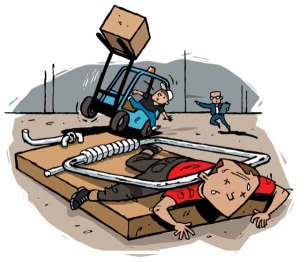Forklift Feature Articles


Mousetrap deaths now top workplace killer
This article by Mitsubishi Forklifts is based on American figures but the same principles about forklift truck tip over hold good no matter where you are in the world.
How one simple step can avoid tragedy in your firm
Recent studies by the European Agency for Safety and Health at Work (OSHA) make grim reading for forklift operators. Tipping accidents are confirmed as one of the biggest causes of fatal accidents in the workplace. In almost all of these cases, the driver was ‘mousetrapped’ between the truck and the ground, causing massive trauma to the head or upper body.
But it need not be like this.
In this issue of Forklift Briefing we explain why trucks tip over - because experts believe that this is not fully understood by many forklift drivers. And while that should be useful, we start this month’s article with a simple truth that you can put into action today to help save the lives of your colleagues and avoid business-busting fines and compensation claims.
Belt up or get cut up
In car driving, the seatbelt system was introduced to restrain the driver in a high speed collision – preventing him or her from hitting the steering wheel or windscreen. So why do forklift trucks have a seatbelt, surely their speeds are much lower?
The surprising truth is that the seatbelt on a forklift is not intended to protect the driver from a collision at speed, but to stop him from his natural urge to jump free.... to his death.
Seatbelts in forklifts are designed to prevent drivers sliding from the seat in an upward and outward direction, as doing so increases the risk of a driver having his head trapped or crushed between the overhead guard and the floor.
Coroners’ Inquests hear ever more tragic and gruesome cases of how, as a forklift truck starts to tip over, the human brain makes the driver try and get out of the truck. And how, in trying to save themselves in this way, they often die. The driver is ‘mousetrapped’ between the overhead guard and the ground with fearful injuries.
How to survive the mousetrap
Without a seatbelt, you can try and stay safe in a tipping accident with these three points:
- Lean away from the direction of tipping
- Grip steering wheel – or, better still, the grab handles – to help stay in your seat
- Push down with your feet to force yourself back into the seat
But best of all – wear a seatbelt! (Webmaster note: It's been a legal requirement to wear a seatbelt on a forklift truck since 2002 in the UK)
No amount of training, experience or knowledge seems to stop people trying to ‘beat the mousetrap’. If only the driver could keep his nerve, stay inside the cab, perhaps bracing himself with the steering wheel or grab handles. The driver may be bruised, but there are virtually no fatalities on record of this type of accident.
Studies have shown that the urge to jump is so irresistible that the best safety precaution of all is to wear a seatbelt – to stop the driver jumping out!
So this is what you can do today to start saving lives: make it a company rule that every driver must wear their seat restraint at all times. If you see someone in your workplace driving without a seat restraint, stop them and insist they wear it. Make sure your colleagues know the story too.
It may not be very ‘macho’ to belt up on a slow-moving forklift, but remember it is better to belt up than to get smashed up.